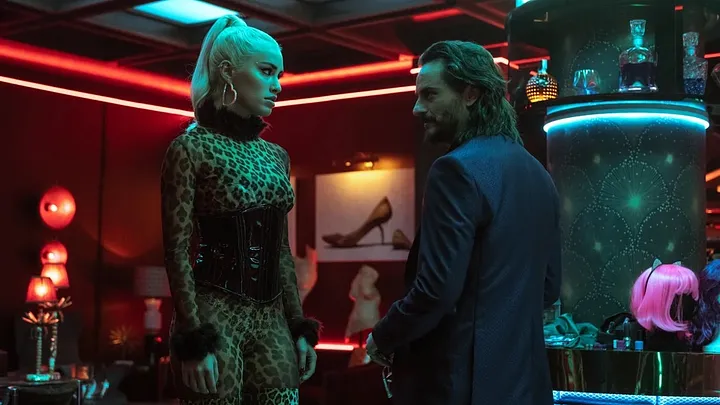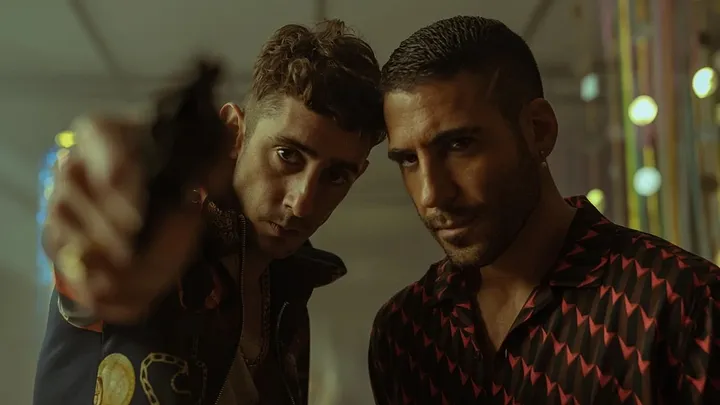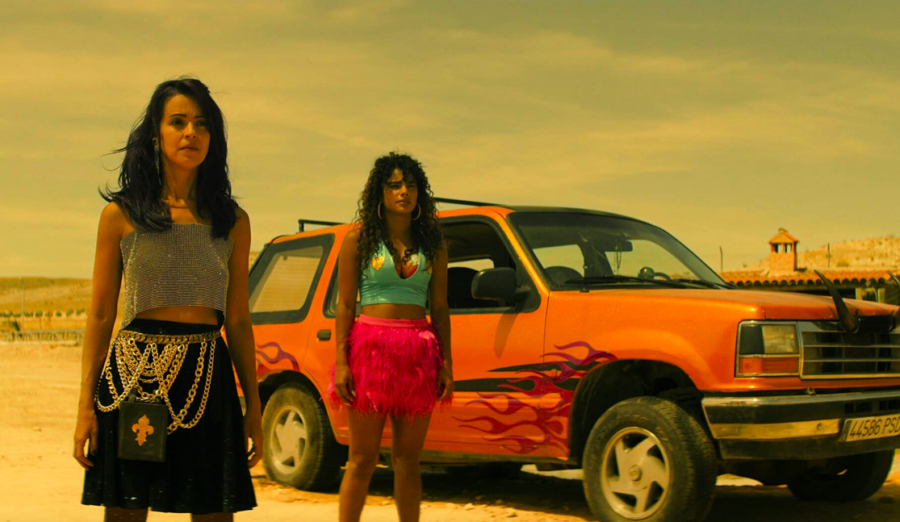Trigger warning for mentions of sexual violence. Contains spoilers.
Early 2021, Netflix released Sky Rojo, a Spanish action crime drama following three prostitutes, who attempt to flee from their employer but get roped in a frantic and chaotic journey to save themselves from their previous life. Made by the creators of the international hit-series La Casa de Papel, the series shares pulpy similarities with much of Tarantino’s filmography and is described as showing “the impunity, ambiguity and brutal reality of prostitution, and the psychological portraits of those on both sides of the scale.”
What’s it all about?
Sky Rojo pursues the stories of Coral (Verónica Sánchez), Wendy (Lali Espósito) and Gina (Yany Prado), three prostitutes working at the Las Novias Club, a strip club and brothel in Tenerife, owned by the sleazy and abusive Romeo (Asier Etxeandia). The series commences with Gina confronting Romeo after his wife’s funeral with a roll of cash she had saved in attempt to pay her debts and leave the club. She is rebuffed by Romeo and when she hits him in anger, Romeo stabs her repeatedly with a pen until Coral and Wendy intervene. After Wendy knocks him out, the girls run away in fear of getting arrested (or worse) as the vengeful Romeo sends his henchmen, Moises (Miguel Ángel Silvestre) and his brother, Christian (Enric Auquer) to bring them back.
The story of each girl is unraveled over the course of the series; Gina was scouted by Moises under the guise of a better job opportunity overseas when in reality, her family had sold her to Romeo in exchange for financial support. Gina ends up falling for one of her clients, who impregnates her and promises to look after her and the baby. However, following her escape from the club, she realizes than he never intended to start a legitimate relationship with her and only saw her as means for sex. Similarly, Wendy was also recruited under the impression of overseas employment, which she had readily accepted as to escape her dangerous living situation and provide her girlfriend with money to find them a better home. Before she could leave the club, Wendy finds herself abandoned by her girlfriend, who leaves her with a heavy debt she is unable to repay.

Compared to both Gina and Wendy, who were betrayed by their loved ones and one of the many girls trafficked for sex, Coral is a clear outlier. The only girl who arrived at the club voluntarily, Coral is a mystery to even Romeo. She is more educated than the other girls at the club and carries herself with a sense of cheeky gentility that results in the man developing an unhealthy obsession towards her, leading him to even hire her as a tutor for his children during the day so he could spend more time with her. Though the series does not go into detail on Coral’s background, it is implied that she was married before she arrived at the club and was in hiding after committing murder. She begins ingesting drugs as a coping mechanism and ultimately becomes addicted- a major factor skewing the girls’ plans for survival.
Complex storylines and character interactions
The storylines in Sky Rojo focus on elements of love and friendship, particularly between the three women as they face the dangers of escaping Romeo. It highlights how they are stronger when they work together and the importance of having someone to support you in the making difficult decisions. Despite Sky Rojo’s attempts at presenting a story of women overcoming the worst parts of a patriarchal system, it pans out as faux-feminist and a lackluster attempt at female empowerment. Even as a series fixated on the horrors of human trafficking and forced prostitution, a number of scenes centralize on pandering to the male gaze. There are extensive lingering shots of women being coerced into sexual acts and degraded for the pleasure of the men around them. Even after their escape, Wendy is cornered by a former customer in a restaurant bathroom and violently raped- the whole ordeal is chronicled through her tear-stained face and is painful to watch.
Additionally, Asier Etxeandia’s Romeo is often seen parading the women around the club in little to no clothing and referring to them as objects for male fantasies. The women’s bodies are constantly fetishised, degraded and criticised; in one such scene, a girl with a naturally small chest is forced to get her breasts augmented against her will for the sake of getting more customers- the money from her procedure is later added to her debt to the club. The girls are also shown to be compelled into unwanted group sex where they are repeatedly violated and brutalized by male customers. While some may argue that these scenes are an accurate depiction of what goes on behind the scenes in human trafficking and prostitution, Sky Rojo presents an excessive and graphic amount of sexual violence, almost to a perverse degree. In one particular scene where Romeo’s men are celebrating at his club, an inebriated Christian prevents one of the men from leaving early and viciously sodomizes him in front of everyone, under the pretense of a “joke”. Not only is the scene deeply uncomfortable for the people watching, it is also a subtle reference to how sexual assault against men are often neglected and unrecognized in communities.

Problematic content
In spite of these scenes, the Sky Rojo has no shortage in efforts to humanize sexual offenders. Romeo is perceived as a lonely widower left with two young daughters after his wife’s battle with cancer- her funeral had almost no attendees aside from Romeo’s own employees, indicating how disliked he was in the community. The brothers, Moises and Christian, have their own tragic backstory; Moises is indebted to Romeo after the latter helped get rid of their abusive father and supported them financially when taking care of their ailing mother. Compared to the older and more capable Moises, Christian is insecure and shown to have issues with sobriety and gaining the favor of their mother. Even the man who raped Wendy in the bathroom, is projected to gain sympathy from the audience after he later ends up helping the women steal from Romeo. Such moments seem to enable the audience to pardon their actions and perceive them as “mistakes” after character development- furthering society’s very real tendency to forgive sexual offenders and dismiss their offenses as “lapses in judgement” while dispelling the lifetime of trauma experienced by survivors.
Regardless of the problematic content, Sky Rojo continues as a deeply thrilling watch. With fast-paced cinematography embellished with visuals akin to 90’s pop music videos, each episode is approximately 30 minutes long and filled to the brim with unpredictable twists and turns. Coral, Wendy and Gina face several challenges during their escape, from gunshot wounds to being secretly tracked, and in the face of danger, their solutions are both quick-witted and borderline comedic. Even with freedom so easily in their grasp, these characters do not fail to consider the moral quandaries of their actions. For instance, when they find an injured man in their getaway vehicle, the women are waylaid by their decision to get him medical attention despite Romeo closing in on them. Similarly, though the women get multiple opportunities to eliminate Romeo and their adversaries, they choose to save themselves through the least violent solution. These moments further contribute to the women’s characters, allowing the audience to develop a rapport with them while also rooting for them.
Why you should watch
With excellent performances and electrifying plotlines, Sky Rojo is no doubt one of the most impressive shows in Netflix’s repertoire. The punchy cliffhangers coupled with the inhuman realities in prostitution and human trafficking, enable the audience to experience varying emotional frequencies while acclimating themselves to the foreign silver screen outside of traditional Hollywood series. Nevertheless, Sky Rojo is constantly balancing on a tightrope between empowering women and exploiting them, and thus, fails to call emphasis on the points on female friendship and sisterhood that the series attempts to fasten itself to.
Check out:
The ‘New Normal’: Climate Change and Its Link to Canada’s Worst Wildfire Season







Be First to Comment